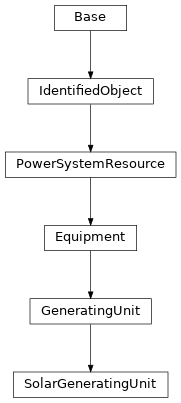cimpy.cgmes_v2_4_15.SolarGeneratingUnit module
- class cimpy.cgmes_v2_4_15.SolarGeneratingUnit.SolarGeneratingUnit(*args, **kw_args)[source]
A solar thermal generating unit.
Documentation of parent class GeneratingUnit:
A single or set of synchronous machines for converting mechanical power into alternating-current power. For example, individual machines within a set may be defined for scheduling purposes while a single control signal is derived for the set. In this case there would be a GeneratingUnit for each member of the set and an additional GeneratingUnit corresponding to the set.
- ControlAreaGeneratingUnit:
ControlArea specifications for this generating unit. Default: “list”
- GrossToNetActivePowerCurves:
A generating unit may have a gross active power to net active power curve, describing the losses and auxiliary power requirements of the unit. Default: “list”
- RotatingMachine:
A synchronous machine may operate as a generator and as such becomes a member of a generating unit. Default: “list”
- genControlSource:
The source of controls for a generating unit. Default: None
- governorSCD:
Governor Speed Changer Droop. This is the change in generator power output divided by the change in frequency normalized by the nominal power of the generator and the nominal frequency and expressed in percent and negated. A positive value of speed change droop provides additional generator output upon a drop in frequency. Default: 0.0
- initialP:
Default initial active power which is used to store a powerflow result for the initial active power for this unit in this network configuration. Default: 0.0
- longPF:
Generating unit long term economic participation factor. Default: 0.0
- maxOperatingP:
This is the maximum operating active power limit the dispatcher can enter for this unit. Default: 0.0
- maximumAllowableSpinningReserve:
Maximum allowable spinning reserve. Spinning reserve will never be considered greater than this value regardless of the current operating point. Default: 0.0
- minOperatingP:
This is the minimum operating active power limit the dispatcher can enter for this unit. Default: 0.0
- nominalP:
The nominal power of the generating unit. Used to give precise meaning to percentage based attributes such as the governor speed change droop (governorSCD attribute). The attribute shall be a positive value equal or less than RotatingMachine.ratedS. Default: 0.0
- normalPF:
Generating unit economic participation factor. Default: 0.0
- ratedGrossMaxP:
The unit`s gross rated maximum capacity (book value). Default: 0.0
- ratedGrossMinP:
The gross rated minimum generation level which the unit can safely operate at while delivering power to the transmission grid. Default: 0.0
- ratedNetMaxP:
The net rated maximum capacity determined by subtracting the auxiliary power used to operate the internal plant machinery from the rated gross maximum capacity. Default: 0.0
- shortPF:
Generating unit short term economic participation factor. Default: 0.0
- startupCost:
The initial startup cost incurred for each start of the GeneratingUnit. Default: 0.0
- totalEfficiency:
The efficiency of the unit in converting the fuel into electrical energy. Default: 0.0
- variableCost:
The variable cost component of production per unit of ActivePower. Default: 0.0
Documentation of parent class Equipment:
The parts of a power system that are physical devices, electronic or mechanical.
- EquipmentContainer:
Container of this equipment. Default: None
- OperationalLimitSet:
The operational limit sets associated with this equipment. Default: “list”
- aggregate:
The single instance of equipment represents multiple pieces of equipment that have been modeled together as an aggregate. Examples would be power transformers or synchronous machines operating in parallel modeled as a single aggregate power transformer or aggregate synchronous machine. This is not to be used to indicate equipment that is part of a group of interdependent equipment produced by a network production program. Default: False
Documentation of parent class PowerSystemResource:
A power system resource can be an item of equipment such as a switch, an equipment container containing many individual items of equipment such as a substation, or an organisational entity such as sub-control area. Power system resources can have measurements associated.
- Controls:
Regulating device governed by this control output. Default: “list”
- Location:
Location of this power system resource. Default: None
- Measurements:
The power system resource that contains the measurement. Default: “list”
Documentation of parent class IdentifiedObject:
This is a root class to provide common identification for all classes needing identification and naming attributes.
- DiagramObjects:
The domain object to which this diagram object is associated. Default: “list”
- description:
The description is a free human readable text describing or naming the object. It may be non unique and may not correlate to a naming hierarchy. Default: ‘’
- energyIdentCodeEic:
The attribute is used for an exchange of the EIC code (Energy identification Code). The length of the string is 16 characters as defined by the EIC code. References: Default: ‘’
- mRID:
Master resource identifier issued by a model authority. The mRID is globally unique within an exchange context. Global uniqueness is easily achieved by using a UUID, as specified in RFC 4122, for the mRID. The use of UUID is strongly recommended. For CIMXML data files in RDF syntax conforming to IEC 61970-552 Edition 1, the mRID is mapped to rdf:ID or rdf:about attributes that identify CIM object elements. Default: ‘’
- name:
The name is any free human readable and possibly non unique text naming the object. Default: ‘’
- shortName:
The attribute is used for an exchange of a human readable short name with length of the string 12 characters maximum. Default: ‘’
Inheritance Diagram:
